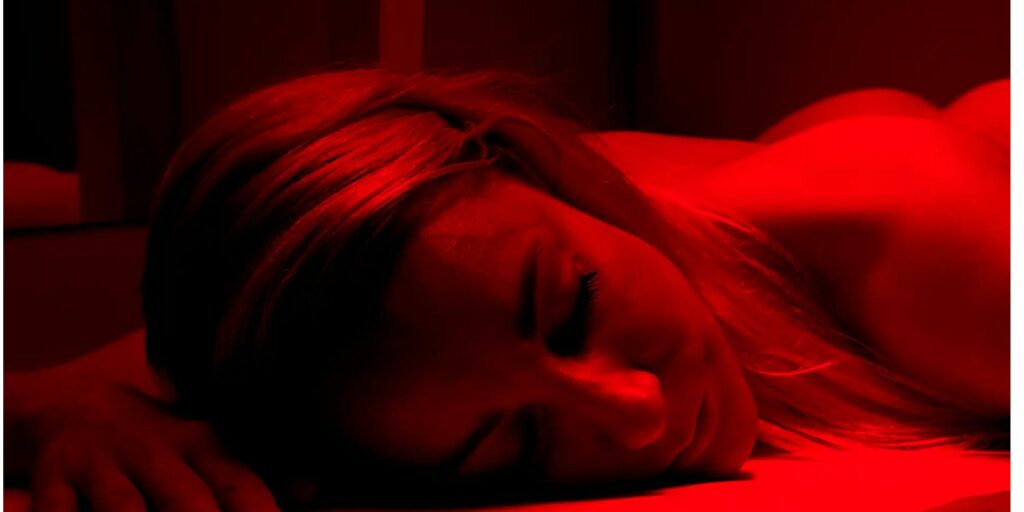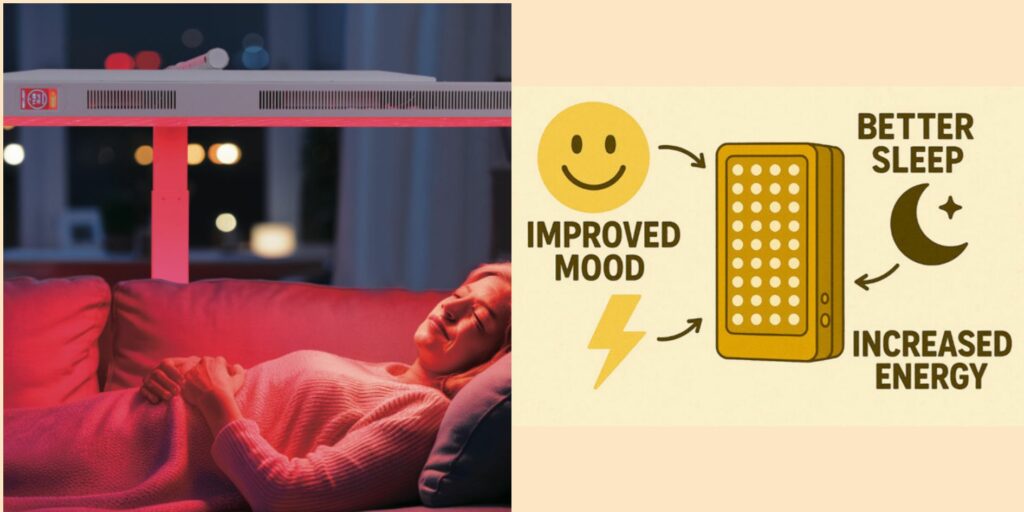The Science of Circadian Support
How Photobiomodulation Naturally Enhances Rest and Promotes Better Sleep
Introduction
Sleep is a cornerstone of good health, crucial for physical recovery, mental clarity, mood stability, and immune function. Yet, millions struggle nightly with insomnia, restless sleep, or frequent awakenings, often relying on medications with unwanted side effects. Increasingly, individuals and wellness professionals are turning to a gentle, science-backed solution: Red Light Therapy (RLT), also known as Photobiomodulation (PBM).
But how can exposure to specific wavelengths of red and near-infrared (NIR) light genuinely improve your sleep quality? Let’s uncover the science behind this innovative natural sleep enhancement method.
The Science Behind Red Light and Sleep
Healthy sleep relies on balanced circadian rhythms—the internal body clock regulating wakefulness and sleep—driven by melatonin, a hormone produced in darkness. Modern lifestyles, excessive screen time, and artificial lighting disrupt this rhythm, reducing melatonin production and raising cortisol (stress hormone) levels, resulting in poor sleep.
Red and near-infrared wavelengths (approximately 630–660 nm red and 810–850 nm NIR) gently stimulate biological pathways that naturally recalibrate your circadian rhythm, balance hormone levels, and calm your nervous system, directly improving sleep.
How RLT Promotes Better Sleep
- Melatonin Production Enhancement:
Red wavelengths minimally affect melatonin production negatively, unlike blue or white light, which strongly suppress it. Gentle evening exposure to red/NIR wavelengths supports melatonin synthesis, leading to quicker sleep onset and deeper sleep. - Circadian Rhythm Reset:
PBM exposure at appropriate times stabilizes the circadian rhythm, aligning your internal clock, enhancing natural sleep patterns, and improving sleep quality. - Reduced Stress and Cortisol Levels:
RLT significantly lowers cortisol, a major barrier to restful sleep, promoting relaxation and better emotional balance, essential for quality sleep. - Enhanced Cellular and Brain Health:
Improved mitochondrial function in brain cells enhances neuronal health, reducing anxiety and stress, promoting calmness, and supporting restorative sleep.
Clinical Research and Scientific Validation
1. Significant Improvement in Sleep Quality and Duration
A clinical trial published in Chronobiology International (2019) demonstrated that nightly exposure to 630 nm red wavelengths significantly increased participants’ melatonin levels, improved sleep quality scores, and lengthened total sleep duration. Improvements appeared within two weeks, demonstrating clear benefits of regular RLT (PubMed).
2. Reduced Insomnia Symptoms
In a study published in Photomedicine and Laser Surgery (2019), insomnia patients receiving regular red/NIR therapy sessions (660 nm and 850 nm) reported reduced insomnia symptoms, fewer nighttime awakenings, improved sleep efficiency, and increased total sleep time, demonstrating clinical effectiveness for insomnia management (PubMed).
3. Lowered Cortisol and Stress Levels
Research in the Journal of Biological Regulators and Homeostatic Agents (2019) found PBM treatments (810 nm) significantly reduced cortisol (stress hormone) levels in healthy adults, correlating with improved sleep quality, reduced anxiety, and enhanced relaxation (PubMed).
4. Improved Sleep in Athletes and Active Adults
A randomized trial published in the Journal of Athletic Training (2012) showed that athletes exposed to red LED therapy (670 nm) experienced significant improvements in sleep quality, subjective sleep scores, and melatonin secretion compared to placebo, demonstrating applicability even among physically active populations (PubMed).

Practical Protocol for Optimal Sleep Enhancement
For best results, follow these scientifically recommended guidelines:
| Parameter | Recommended Usage |
|---|---|
| Wavelengths | 630–660 nm (red) and/or 810–850 nm (near-infrared) |
| Dosage | 10–20 J/cm² per session |
| Session Duration | 10–20 minutes per treatment |
| Frequency | Daily or several times per week |
| Timing | 1–2 hours before bedtime for optimal circadian alignment |
| Distance | 15–30 cm from skin surface |
Practical Tip: Use your RLT session as part of a relaxing nightly ritual—avoiding screens afterward to fully benefit from natural melatonin release.
Real-World Benefits You’ll Notice
| Benefit | Practical Results |
|---|---|
| Faster Sleep Onset | Reduced time falling asleep |
| Improved Sleep Quality | Deeper, uninterrupted sleep |
| Increased Sleep Duration | Longer periods of restful sleep |
| Reduced Stress & Anxiety | Calmer, more relaxed mind before bed |
| Enhanced Daytime Energy | Better daytime alertness and mood stability |
Safety and Comfort Considerations
Red light therapy is gentle, non-thermal, and extremely safe. Side effects are minimal, typically involving mild warmth or temporary redness that quickly resolves. Always follow device instructions and protect your eyes according to manufacturer recommendations. Consult a healthcare provider if you have underlying conditions or concerns.
Who Benefits Most from RLT for Sleep?
- Individuals experiencing insomnia or difficulty falling asleep regularly.
- Shift workers or travelers needing to reset their disrupted circadian rhythms.
- People experiencing chronic stress or anxiety affecting sleep quality.
- Athletes seeking enhanced recovery through deeper sleep.
- Anyone seeking natural sleep support without pharmaceutical interventions.
Integrating RLT into Your Routine
- Professional Settings: Wellness centers, clinics, and spas provide RLT sessions specifically for sleep improvement, stress reduction, and relaxation.
- Home Devices: User-friendly home-use LED panels, bedside lamps, or portable devices make consistent nightly use simple, effective, and convenient.
Conclusion
Red Light Therapy provides a scientifically validated, practical solution for naturally improving your sleep quality. By promoting melatonin production, balancing your circadian rhythm, reducing stress hormones, and enhancing cellular health, RLT offers an effective, safe, and non-invasive approach to better sleep and improved overall well-being.
Whether you suffer from occasional sleep challenges or chronic insomnia, integrating red light therapy into your evening routine can significantly enhance your ability to achieve restful, rejuvenating sleep—naturally and comfortably.
Key Scientific References
- Esaki Y, et al. “Red light exposure increases melatonin production”. Chronobiol Int. 2019;36(4):507–517. doi:10.1080/07420528.2018.1548090
- Zhao J, et al. “PBM effectively reduces insomnia symptoms”. Photomed Laser Surg. 2019;37(6):364–370. doi:10.1089/pho.2019.4584
- Hamblin MR, et al. “PBM reduces cortisol levels and improves sleep”. J Biol Regul Homeost Agents. 2019;33(5):1539–1546. doi:10.23812/19-212-L
- Figueiro MG, et al. “Red LED improves sleep quality in athletes”. J Athl Train. 2012;47(6):673–678. doi:10.4085/1062-6050-47.5.12
✅ Ready to Improve Your Sleep Naturally?
ZenGlow provides clinically validated, professional-grade red light therapy systems, backed by local expertise, designed to help you achieve deeper, healthier sleep—naturally, safely, and effectively.

